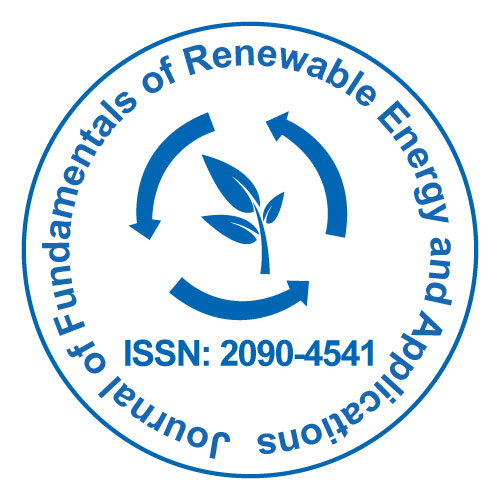
Journal of Fundamentals of Renewable Energy and Applications
Open Access
ISSN: 2090-4541

ISSN: 2090-4541
Commentary Article - (2024)Volume 14, Issue 4
As the world transitions to a cleaner, more sustainable energy future, renewable energy sources like solar, wind, and hydroelectric power are increasingly becoming integral parts of the global energy mix. However, the inherent intermittency of renewable energy sources-solar power that fluctuates with the time of day and weather conditions, and wind power that is subject to variable wind speeds-presents challenges for ensuring a consistent and reliable energy supply. High-efficiency storage technologies play an essential role in overcoming these challenges, allowing renewable energy to be stored when it is abundant and released when needed, ensuring a stable and reliable power grid. This article explains the latest developments in high-efficiency storage technologies and their potential to expand the use of renewable energy. One of the biggest barriers to the widespread adoption of renewable energy is its variability. Unlike traditional fossil fuels, renewable sources are not available on-demand, making it difficult to match supply with fluctuating demand. Energy storage systems help address this issue by allowing excess energy produced during periods of high generation to be stored and released when energy production is low or demand is high. Energy storage also helps balance the grid by smoothing out short-term fluctuations in energy supply and demand, improving grid stability and reducing the risk of blackouts.
High-efficiency energy storage systems are particularly important as renewable energy penetration increases. These systems must not only provide reliable storage capacity but also be costeffective, scalable, and environmentally sustainable. In this context, several storage technologies have emerged as promising solutions for expanding the use of renewable energy. Pumped Hydro Storage (PHS) is one of the oldest and most widely used energy storage technologies. When energy demand is high, water from the upper reservoir is released to flow downhill through turbines, generating electricity.
PHS is capable of storing large amounts of energy and providing long-duration storage, making it suitable for grid-scale applications. Modern pumped hydro storage systems can achieve round-trip efficiencies of around 70%-80%, making them relatively efficient for long-term energy storage. PHS is a wellestablished technology with decades of operational experience. However, pumped hydro storage has limitations, such as the need for specific geographic conditions, including access to a suitable water source and significant elevation differences between reservoirs. Furthermore, the construction of pumped hydro plants can be expensive and time-consuming, which can limit their deployment in regions without the necessary resources. Compressed Air Energy Storage (CAES) is another promising technology for storing renewable energy. In a CAES system, excess electricity is used to compress air and store it in underground caverns or above-ground storage tanks. When electricity is needed, the compressed air is released and heated, expanding through turbines to generate electricity. Like pumped hydro, CAES can provide large-scale energy storage, making it suitable for grid stabilization and balancing renewable energy. CAES can store energy for long periods of time, which is beneficial for managing seasonal variations in renewable energy generation. Unlike pumped hydro storage, CAES can be deployed in a variety of locations, as long as there is access to suitable storage sites. However, advances in adiabatic CAES, which recycles heat during the compression process, are expected to improve efficiency and make CAES more competitive in the future. Flow batteries are a type of rechargeable battery in which energy is stored in liquid electrolytes that flow through electrochemical cells to generate electricity. These batteries are particularly wellsuited for large-scale energy storage due to their scalability, long cycle life, and ability to operate in a wide temperature range.
Flow batteries can be easily scaled up or down by increasing the size of the electrolyte tanks, making them highly versatile for different energy storage needs. Flow batteries can store energy for extended periods, making them ideal for applications that require long-duration storage, such as balancing seasonal variations in renewable energy generation. Flow batteries have a long cycle life and require less maintenance compared to other battery technologies. However, flow batteries are currently more expensive and less energy-dense than Li-ion batteries, which limits their widespread adoption. Ongoing research is focused on improving the efficiency, energy density, and costeffectiveness of flow batteries.
High-efficiency energy storage technologies are important for expanding the use of renewable energy and overcoming the challenges posed by its intermittent nature. Lithium-ion batteries, pumped hydro storage, compressed air energy storage, flow batteries, and thermal energy storage are all promising solutions that can help store renewable energy and stabilize the grid. While each technology has its strengths and weaknesses, ongoing research and development are likely to improve their performance, efficiency, and cost-effectiveness in the coming years. As these technologies continue to evolve, they will play a key role in accelerating the global transition to a sustainable and low-carbon energy future.
Citation: Linda M (2024). High-Efficiency Storage Technologies for Expanding Renewable Energy Use. J Fundam Renewable Energy Appl. 14:367.
Received: 27-Nov-2024, Manuscript No. JFRA-24-36237; Editor assigned: 29-Nov-2024, Pre QC No. JFRA-24-36237 (PQ); Reviewed: 13-Dec-2024, QC No. JFRA-24-36237; Revised: 20-Dec-2024, Manuscript No. JFRA-24-36237 (R); Published: 27-Dec-2024 , DOI: 10.35248/2090-4541.24.14.367
Copyright: © 2024 Linda M. This is an open-access article distributed under the terms of the Creative Commons Attribution License, which permits unrestricted use, distribution and reproduction in any medium, provided the original author and source are credited.